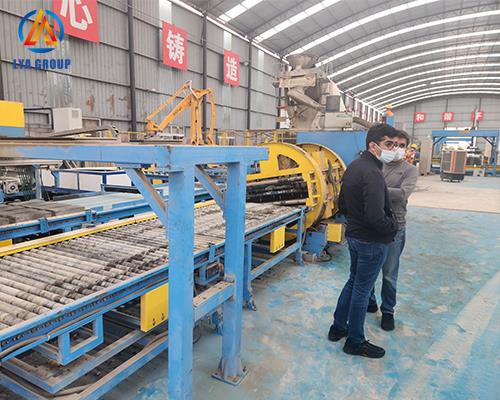Wet concrete semi-automatic production line
News 2024年3月19日 92

A wet concrete semi-automatic production line refers to a production line for manufacturing wet concrete products with a level of automation that involves some manual intervention. It combines both manual operations and automated processes to produce wet concrete products such as concrete blocks, pavers, or other precast concrete elements. The specific configuration and components of a semi-automatic production line can vary depending on the desired output and production capacity. Here are the key features and processes typically involved in a wet concrete semi-automatic production line.
Batching and Mixing: The production process begins with the batching and mixing of the concrete ingredients. The raw materials, including cement, aggregates, water, and additives, are accurately measured and mixed to form a homogenous concrete mixture. This can be done manually or using automated batching systems.
Mold Preparation: The molds or formworks are prepared for casting the wet concrete products. This involves cleaning the molds, applying release agents to ensure easy demolding, and arranging them on the production line.
Concrete Casting: The prepared concrete mixture is poured or placed into the molds. In a semi-automatic production line, this process may involve manual intervention, such as manually filling the molds with the concrete mixture. The molds may be filled by hand or using tools like shovels or buckets.
Compaction: After the concrete is poured into the molds, compaction is necessary to remove air voids and ensure proper consolidation. This can be achieved manually by using vibrating equipment or by employing semi-automatic vibrating tables or compactors.
Curing: Once the wet concrete products are cast and compacted, they need to undergo a curing process to gain strength and durability. Curing can be done through natural curing (air drying) or accelerated curing methods such as steam curing or using curing chambers. The products are typically stacked and protected during the curing process.
Demolding: After the concrete products have sufficiently cured, they are demolded from the molds. This may involve manual demolding, where the molds are manually opened or removed, or the use of semi-automatic demolding equipment that aids in the demolding process.
Finishing and Quality Control: Once demolded, the wet concrete products undergo finishing processes such as trimming, edge profiling, or surface treatment to achieve the desired appearance and quality. Quality control measures are implemented throughout the production line to monitor the consistency, strength, and dimensional accuracy of the products.
Packaging and Distribution: The final step in the semi-automatic production line is the packaging and distribution of the wet concrete products. They are typically stacked, palletized, and prepared for transportation to construction sites or storage facilities.
In a semi-automatic production line, certain steps require manual intervention, while others are automated to improve efficiency and productivity. The extent of automation can vary based on factors such as the production capacity, budget, and specific requirements of the concrete products being manufactured.